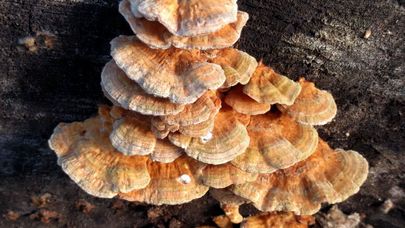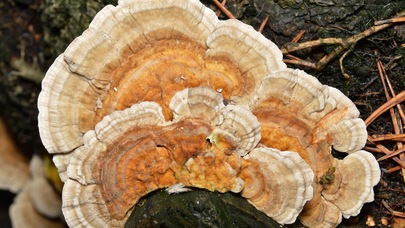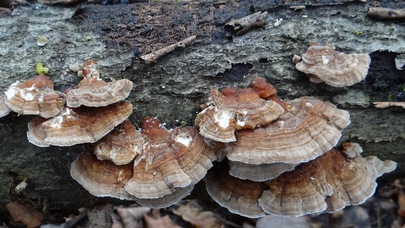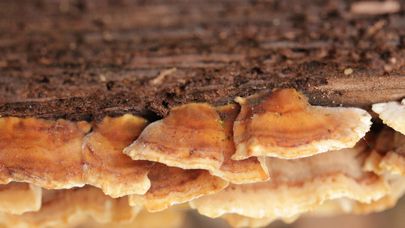Trametes ochracea
Description
Trametes ochracea is a polypore mushroom in the Polyporaceae family. It is characterized by a thicker matte cap, always zonal with ocher, orange-brown, or glandular felt bands and a pale gray to the blackish-gray porous surface with age. As a rule, a smaller number of caps are connected. Grows abundantly on decaying wood of deciduous trees on a thick substrate; prefers moist but bright places, loves the proximity to water.
Due to the diversity, related species, and a partial lack of knowledge/experience, the ocher Tramete is probably one of the most commonly misidentified polypores.
Common names: Ochre Bracket, Gezoneerd elfenbankje (Netherlands), Outkovka Pásovaná (Czech Republic).
Mushroom Identification
Fruiting Bodies
Annual, have the appearance of lateral sessile caps.
Cap
1–3 cm long, 2–7 cm wide, 0.3–0.7 cm thick, semicircular, kidney-shaped, fan-shaped, often narrowed at the base, often joined by bases or shingle groups. The surface of the caps is short-velvety or bare, matte, weakly zoned, with monotonous zones or without zones, covered, yellow-brown, rusty-brown. The edge is thin, sharp, sterile from below, straight or wavy, initially the same color as the surface of the cap, and later lighter.
Tubes and Pores
The hymenophore is tubular. The surface of the hymenophore is white, pale-yellowish, ocher-yellowish, with age yellowish-brownish. Tubes are short, 1-5 mm long. Pores with a diameter of 0.2 - 0.4 mm, rounded or slightly angular, with a density of 3 - 4 per 1 mm.
Flesh
The flesh is thin, cork-leathery, white, becoming cream with age.
Spores
5-6 (7) * 2.5-3 μm, almost cylindrical, flattened or slightly bent on one side, colorless.
Spore Print
White.
Season
June to September.
Habitat
Grows on dead wood, branches, and stumps of deciduous trees (maples, hornbeams, ash trees, poplars, willows, oaks, fruit trees). Causes white rot.
Look-Alikes
-
Less pale and more strongly zoned, with a thin flexible consistency (not rigid and hard), has a black layer in the context, and has slightly smaller pores and spores.
-
Have a black line beneath the surface tomentum of the cap.
-
Has a cap surface with a uniform cream color and is not zoned or very faintly zoned.
History
In 1794 by Christiaan Hendrik Persoon described this specieas and named it Boletus ochraceus. In 1987, American mycologist Robert Lee Gilbertson and Norwegian mycologist Leif Randulph Riwarden renamed the fungus Trametes ochracea.
The genus name Trametes comes from the prefix tram- meaning thin. The specific epithet ochracea is a reference to the ochre coloring of the upper surface of the mushroom.
Synonyms and Varieties
Polyporus zonatus var. ochraceus Fr.
Agaricus multicolor (Schaeff.) E.H.L. Krause, 1932
Bjerkandera zonata (Nees) P. Karsten (1881), Acta societatis pro fauna et flora fennica, 2(1), p. 30
Boletus angulatus Schumacher (1803), Enumeratio plantarum in partibus Saellandiae septentrionalis et orientalis, 2, p. 388
Boletus coriaceus Batsch (1783), Elenchus fungorum, p. 105
Boletus multicolor Schaeffer (1774), Fungorum qui in Bavaria et Palatinatu circa Ratisbonam, 4, p. 91, tab. 269
Boletus ochraceus Pers., 1794
Boletus placenta Schumacher (1803), Enumeratio plantarum in partibus Saellandiae septentrionalis et orientalis, 2, p. 387
Boletus zonatus Nees (1817), Das system der pilze und Schwämme, p. 221, tab. 28, fig. 221
Bulliardia rufescens Lázaro Ibiza (1916), Revista de la real Academia de ciencias exactas, fiscicas y naturales de Madrid, 14, p. 844
Coriolus concentricus Murrill (1907), North American flora, 9(1), p. 23
Coriolus hirsutus ochraceus (Pers.) Maire, 1940
Coriolus hirsutus var. ochraceus(Persoon) Maire (1940), Actes de l'Institut botanique de l'Université d'Athènes, 1, p. 78
Coriolus lloydii Murrill (1907), North American flora, 9(1), p. 23
Coriolus ochraceus (Pers.) Prance, 1984
Coriolus zonatus (Nees) Quélet (1886), Enchiridion fungorum in Europa media et praesertim in Gallia vigentium, p. 175
Daedalea rufescens (Lázaro Ibiza) Saccardo & Trotter (1925), Sylloge fungorum omnium hucusque cognitorum, 23, p. 450
Hansenia zonata (Nees) P. Karsten (1879), Meddelanden af societas pro fauna et flora fennica, 5, p. 40
Microporus multicolor (Schaeffer) Kuntze (1898), Revisio generum plantarum, 3, p. 495
Polyporus aculeatus Velenovský (1922), Ceské houby, 4-5, p. 646
Polyporus angulatus (Schumacher) Fries (1815), Observationes mycologicae praecipue ad illustrandam floram suecicam, 1, p. 127
Polyporus angulatus var. ß placenta(Schumacher) Persoon (1825), Mycologia europaea, seu complet omnium fungorum in variis europaeae regionibus detectorum enumeratio, 2, p. 73
Polyporus batschii Persoon (1825), Mycologia europaea, seu complet omnium fungorum in variis europaeae regionibus detectorum enumeratio, 2, p. 85
Polyporus leucoloma Persoon (1825), Mycologia europaea, seu complet omnium fungorum in variis europaeae regionibus detectorum enumeratio, 2, p. 65
Polyporus lloydii (Murrill) Overholts (1914), Annals of the Missouri botanical Garden, 1(1), p. 95
Polyporus ochraceus (Persoon) Fries (1815), Observationes mycologicae praecipue ad illustrandam floram suecicam, 1, p. 127
Polyporus ochraceus tremulae Secretan (1833), Mycographie Suisse, 3, p. 132
Polyporus placenta (Schumacher) Secretan (1833), Mycographie Suisse, 3, p. 129
Polyporus versicolor var. zonatus(Nees) Jørstad (1937) [1936], Det kongelige norske videnskabers selskabs skrifter, 10, p. 44
Polyporus versicolor var. ochraceus (Persoon) Persoon (1825), Mycologia europaea, seu complet omnium fungorum in variis europaeae regionibus detectorum enumeratio, 2, p. 72
Polyporus zonatus (Nees) Fries (1821), Systema mycologicum, 1, p. 368
Polyporus zonatus var. ß ochraceus (Persoon) J. Kickx f. (1867), in J.J. Kickx, Flore cryptogamique des Flandres, 2, p. 232
Polystictus concentricus (Murrill) Saccardo & Trotter (1912), Sylloge fungorum omnium hucusque cognitorum, 21, p. 313
Polystictus imperfectus (Peck) Sacc. 1899
Polystictus lloydii (Murrill) Saccardo & Trotter (1912), Sylloge fungorum omnium hucusque cognitorum, 21, p. 316
Polystictus multicolor (Schaeffer) Saccardo (1916), Flora italica cryptogama. Pars 1: Fungi. Hymeniales, 1(15), p. 1023
Polystictus ochraceus (Pers.) Lloyd, 1917
Polystictus zonatus (Nees) Fries (1851), Novae symbolae mycologicae. Fasciulus primus, sistens fungos in peregrinis terris a botanicis danicis nuper collectos, p. 70
Polystictus zonatus var. ochracea (Persoon) Gillot & Lucand (1890), Société d'histoire naturelle d'Autun, Bulletin, 3, p. 170
Trametes multicolor (Schaeffer) Jülich (1982), Persoonia, 11(4), p. 427
Trametes ochracea (Persoon) Gilbertson & Ryvarden (1987), North American Polypores, 2, p. 752
Trametes zonata (Nees) Pilát (1939), Atlas des champignons de l'Europe, 3, Polyporaceae, p. 263
Trametes zonatella Ryvarden (1978), Polyporaceae of North Europe, 2, p. 436
Photo sources:
Photo 1 - Author: Jerzy Opioła (CC BY-SA 3.0)
Photo 2 - Author: Michel Langeveld (CC BY-SA 4.0)
Photo 3 - Author: Ryan Hodnett (CC BY-SA 4.0)
Photo 4 - Author: Jerzy Opioła (CC BY-SA 3.0)
Photo 5 - Author: Björn S.(CC BY-SA 2.0)





